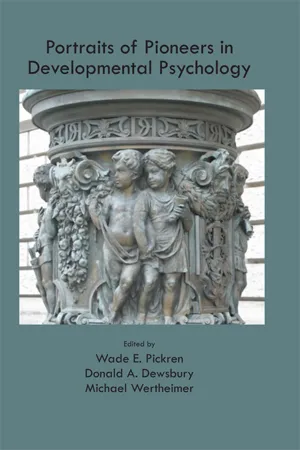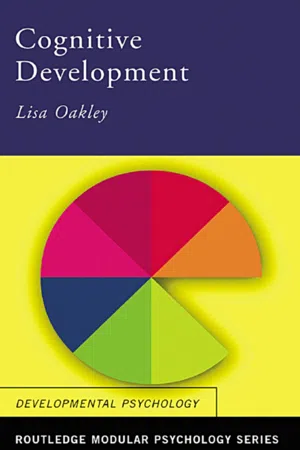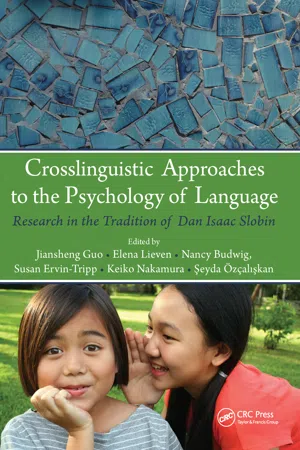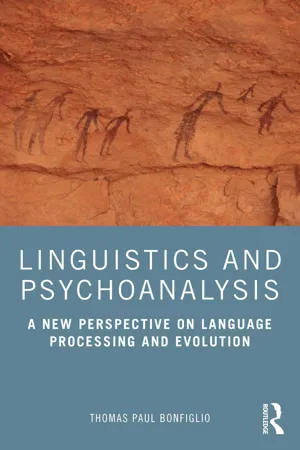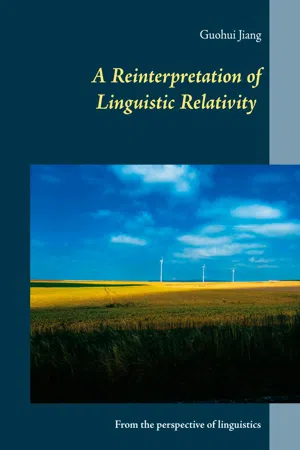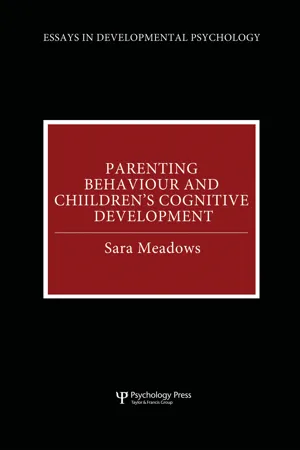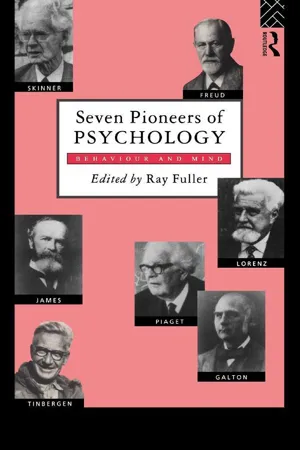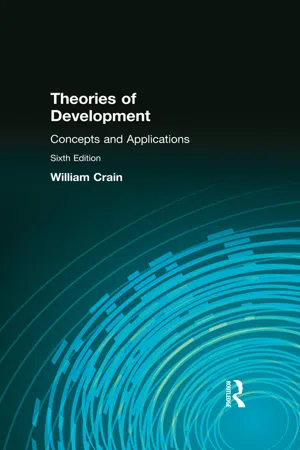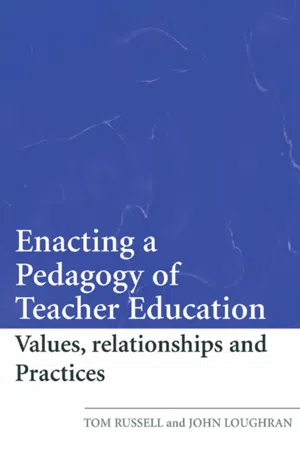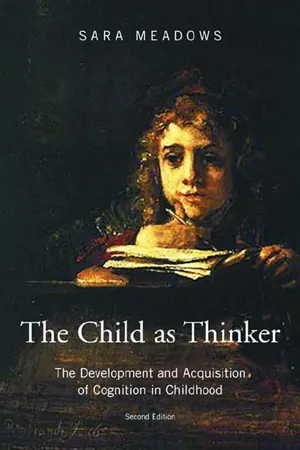Languages & Linguistics
Piaget
Piaget was a Swiss psychologist known for his influential theory of cognitive development in children. He proposed that children progress through distinct stages of cognitive development, from sensorimotor to formal operational stages, and that language development is closely linked to these stages. Piaget's work has had a significant impact on our understanding of how children acquire language and cognitive skills.
Written by Perlego with AI-assistance
Related key terms
Related key terms
1 of 4
Related key terms
1 of 3
12 Key excerpts on "Piaget"
- Wade Pickren, Donald A. Dewsbury, Michael Wertheimer, Wade Pickren, Donald A. Dewsbury, Michael Wertheimer(Authors)
- 2012(Publication Date)
- Psychology Press(Publisher)
6Jean Piaget:Theorist of the Child’s Mind
BERNARD C. BEINSIthaca CollegeJean Piaget (b. August 9, 1896, d. September 16, 1980) has had more influence on the study of cognitive development than any other psychologist. As soon as his first books appeared, psychologists recognized the fertility of his ideas, even though those ideas had to make a linguistic journey from French to English, a translatlantic journey from Switzerland to the United States, and a methodological journey from more philosophical to more psychological. Piaget’s theory of cognitive development continues to dominate developmental psychology over 80 years after its introduction.Figure 6.1 Jean Piaget. (Courtesy of the Jean Piaget Society. With permission.)Piaget’s background mirrored that of the earliest generation of psychologists in his combined focus on the natural sciences and philosophy. Piaget credited his early work in the natural sciences with keeping his focus scientific, but he also maintained a European flavor to his ideas with a greater attachment to philosophy and logic than was common among psychologists in English-speaking countries at the time.Even with the shared background, however, Piaget developed his ideas largely independently of mainstream experimental psychology of the 1920s, which was already being led by English-speaking, behaviorally oriented psychologists in the United States. Piaget’s empirical approach was called “clinical,” relying on small samples and attention to children’s verbal statements to provide insights into cognitive processes. This approach was at variance with American psychology in that the latter had moved away from the study of mental processes that featured so prominently in Piaget’s work. In addition, whereas Piaget tended to study small numbers of children, American psychology had moved toward studying groups, averaging out the effect of unusual behaviors that might have been of great interest to Piaget. The few structuralists of Edward Bradford Titchener’s bent who remained active in psychology in Piaget’s early years would not have studied children because of the children’s relatively limited verbal skills. Their inability to report their introspections would have ruled them out as experimental participants.- eBook - ePub
Portraits of Pioneers in Psychology
Volume III
- Michael Wertheimer, Gregory A. Kimble(Authors)
- 2013(Publication Date)
- Psychology Press(Publisher)
Chapter 9 The Legacy of Jean Piaget Edward Zigler Elizabeth GilmanIt has frequently been asserted that no theoretical framework has had a greater impact on developmental psychology than that of Jean Piaget (Beilin & Pufall, 1992; Flavell, 1996). Using concepts from biology, psychology, philosophy, and mathematics to examine the manner in which children learn about the world, Piaget gave us a remarkably well-articulated and integrated theory of cognitive development. A highly productive worker, he published some 70 books and over 100 articles in psychology. Despite criticisms of the limitations and the lack of objectivity of Piaget’s methods (see e.g., Gopnik, 1996; Lourenco & Machado, 1996), our understanding of children’s intellectual development would never have evolved as it has without his pioneering efforts. Piaget’s theoretical formulations have stimulated a vast amount of research. This chapter, written in the year that marks the 100th anniversary of Piaget’s birth, provides an appropriate occasion for the celebration of his achievements and the deep and continuing influence of his work.Piaget’s Early Life and WorkJean Piaget was born in the Swiss university community of Neuchatel in 1896. His mother was intelligent and religious and his father was a historian with a special interest in medieval literature. Piaget took up serious scientific pursuits at a youthful age. He showed an early passion for observing nature and a precocious interest in biology and psychology (Brainerd, 1996; Evans, 1973). His interest in biology resulted in a publication when he was only 10 years old—an article describing a rare albino sparrow that he had seen in a local park. Shortly thereafter, he began assisting in the local natural history museum, where he helped classify its zoology collection. He began studying molluscs and published articles on them when he was still in his teens. As a result of these articles, Piaget was offered a curator’s position at the Geneva museum of natural history—one that he was forced to decline in order to finish school. He was 14 years old at the time. - eBook - ePub
- Lisa Oakley(Author)
- 2004(Publication Date)
- Routledge(Publisher)
2Piaget’s theory of cognitive development
Introduction
The study of cognitive development is dominated by the theories of two key psychologists – Piaget and Vygotsky. Other theories have been developed but they usually have foundations based upon these key theories.Jean Piaget (1896–1980) was one of the most influential theorists in the field of cognitive development. Piaget was a philosopher, biologist, educationalist and psychologist. He made the decision to study scientifically the way in which children develop knowledge.It was Piaget who first noted that children were not just miniature replicas of adults, but in fact were different in the ways in which they thought about and interpreted the world. Piaget’s idea was that adults did not simply know more than children, but that their knowledge was structured differently. Indeed, Piaget suggested that children at different stages of their development thought about and interpreted their worlds in different ways (Hummel, 1998). Piaget developed the idea of children as ‘ “little scientists” who were engaged in active exploration, seeking understanding and knowledge’ (Bee, 2000:164).Principles of Piaget’s theory
Piaget’s theory of cognitive development was based on three main principles – those of assimilation, accommodation and equilibration. These will be explained below, however, first it is important to define the term ‘schema’.Schema is a cognitive representation of activities or things. When a baby is born it will have an innate schema for sucking in order to ensure that it can feed and therefore grow. As the baby grows this schema will become integrated with other feeding schemas as the baby’s experience and nutrition changes.Assimilation - eBook - ePub
Crosslinguistic Approaches to the Psychology of Language
Research in the Tradition of Dan Isaac Slobin
- Jiansheng Guo, Elena Lieven, Nancy Budwig, Susan Ervin-Tripp, Keiko Nakamura, Seyda Ozcaliskan, Jiansheng Guo, Elena Lieven, Nancy Budwig, Susan Ervin-Tripp, Keiko Nakamura, Seyda Ozcaliskan(Authors)
- 2010(Publication Date)
- Psychology Press(Publisher)
Slobin’s initial probes into the language and cognition puzzle took place during the late 1960s and 1970s, just as the domination of U.S. psychology by behaviorism was waning and it was no longertaboo to speculate about invisible mental representations. For American researchers working on child development, the work of Piaget—already famous in Europe but mostly unknown in the United States—burst on the scene, altering forever the way we looked at infants. Far from being a tabula rasa, Piaget showed, infants are active cognizers, and by the end of the first year and a half of life they have already built up representations of objects, events, locations, and causes.Strange though it now seems, the idea that infants’ conceptual understanding might play an important role in language acquisition was at first not at all obvious. Although it was increasingly acceptable to invoke mental representations, the kinds of representations that at first attracted child language scholars were not those of Piaget but those of Chomsky (1965)—innate notions of putative linguistic universals such as subjects, predicates, direct objects, nouns, and verbs (e.g., McNeill, 1966). Interest in the possible role of cognition in language acquisition came in large part as a reaction to Chomsky. A number of theorists accepted Chomsky’s argument that language involved structures far more complex and abstract than had been envisioned, but they balked at his claim that these structures were innate, and specific to language. Cognitive development seemed to offer an alternative route into the kinds of representations needed.In path-breaking theoretical and empirical work on this possibility, Slobin pointed out that “if you ignore word order, and read through transcriptions of two-word utterances in the various languages we have studied, the utterances read like direct translations of one another… There is a great similarity of basic vocabulary and basic meanings conveyed by the word combinations” (1970, p. 177). The basic meanings identified—to do with location, agency, naming, and the like—were exactly the kinds of meanings that Piaget had stressed in his work on sensorimotor development (Brown, 1973), which suggested that these meanings originate on the basis of universal cognitive processes and are only later mapped to language. - eBook - ePub
Linguistics and Psychoanalysis
A New Perspective on Language Processing and Evolution
- Thomas Paul Bonfiglio(Author)
- 2023(Publication Date)
- Routledge(Publisher)
3 The psychoanalytic linguistics of Jean PiagetDOI: 10.4324/9781003180197-4Humans begin to acquire language during a stage of minimal consciousness, especially a minimal consciousness of self, if at all. Indeed, they become operational in language production before full consciousness is attained. The development of consciousness and of operationality in language are interdependent. Moreover, the stages of the infant production of language must be foundational in its acquisition.The work of the Swiss developmental psychologist Jean Piaget (1896–1980) is most important for placing the origin and development of language in a psychoanalytic context. A Swiss Francophone, Piaget did extensive research on the development of language and consciousness in children, especially as they transition to early adulthood. His work can be easily situated in a psychoanalytic context. It parallels extensively that of Freud, but the two of them differ on the persistence of childhood modes of thought and language into adulthood. Whereas Freud sees a continuum, in which the child remains in the adult—i.e., egocentric, precognitive, and prerational behavioral characteristics remain active in the adult psyche—Piaget prefers to see distinct stages that become jettisoned and left behind—as in rocket launches—as the child develops, although he is never completely clear on this.In La représentation du monde chez l’enfant (1947), Piaget examines the child’s conception of causality, and says that, because thought has not yet attained consciousness of self (conscience du moi) then thought is exposed to continual confusions between the objective and the subjective. This is the state of adualism. The term conscience du moi could also be translated as “consciousness of the ego”, le moi (literally: “the me”) being the French equivalent for the German das Ich - eBook - ePub
- Beryl.A. Geber(Author)
- 2013(Publication Date)
- Routledge(Publisher)
Piaget, J. (1970), Piaget's Theory, in P.H. Mussen (ed.), 'Carmichael's Manual of Child Psychology', vol, 1, New York: Wiley. Piaget, J. (1971), 'Biology and Knowledge', University of Chicago Press. Piaget, J. and INHELDER, B. (1966), 'The Psychology of the Child', London: Routledge & Kegan Paul. SINCLAIR, DE ZWART H. (1969), Developmental Psycholinguistics, in D. Elkind and J.H. Flavell (eds), 'Studies in Cognitive Development', Oxford University Press, pp. 315-36. SINCLAIR, H. (1971), Sensorimotor Action Patterns as a Condition for the Acquisition of Syntax, in R. Huxley and E. Ingram (eds), 'Language Acquisition: modes and methods', Longon: Academic Press. SLOBIN, D.I. (1972a), Cognitive Prerequisites for the Development of Grammar, in D.I. Slobin and C.A. Ferguson (eds), 'Studies of Child Language Development', New York: Holt, Rinehart & Winston. SLOBIN, D.I. (1972b), Seven Questions about Language Development, in P.C. Dodwell (ed.), 'New Horizons in Psychology', Harmondsworth: Penguin Books. SZAGUN, G. (1976), The Acquisition of Tense and Aspect in Young English and German Children, Ph.D. thesis, University of London.Passage contains an image
Chapter 8 Towards a Developmental Social Psychology
Beryl A. GeberIntroduction
This paper is an exploratory one: it aims to bring into contact related developments in social and developmental psychology by focusing specifically on the question: how does the developing child construe his social and personal world? While we will not present a definite solution to this, a number of strands of research can be woven together to provide the canvas on which a picture can be sketched.It is in the field of developmental psychology that the major explosion of theory and research has occurred over the past decade. The exploration of the child's visual and arousal systems, understanding neonatal capacities, detailing the relationship between mother and child, documenting linguistic skills and particularly analysing the processes of intellectual growth have all contributed to bring about a new appreciation of the process of development. But it is not only developmental psychology which has been the beneficiary of this growth: the divisions within psychology are traditional and expedient rather than substantive. The problems examined by developmentalists: cognition, concept formation, language, thinking and reasoning, are increasingly of importance in the field of psychology as a whole. And so too is another change in emphasis - the interest in the interactive framework within which development occurs. - eBook - ePub
A Reinterpretation of Linguistic Relativity
From the perspective of linguistics
- Guohui Jiang(Author)
- 2020(Publication Date)
- Books on Demand(Publisher)
Linguists are in turn inclined to quote data and conclusions of psychological research as arguments of their postulations. Among psychologists referred to frequently in earlier stage of LR study Vygotsky and Piaget were favorites, yet their theories are regarded as arguments for debate on LR not because they are themselves relevant to the doctrine of LR, rather researchers of LR have selectively understood and applied certain viewpoints of these psychological theories in favor of their own predefined position. Psychologists’ postulations such as pre-language thinking vs. pre-thought language, conceptualization and development of logical reasoning of nonverbal infants etc. are frequently cited as the counter-evidence against LR. Few proponents of LR, to my knowledge, have found out support from Vygotsky’s and Piaget’s works, among which the prominent position is maintained by Lucy (1987, 1988, and 2010).Such sharp confrontation might be expected in whichever study of the speech-thinking mechanism and function of human brain, any speculations of the language-thinking relation can be argued, upheld or criticized logically until the “black box” of human brain will be experimentally revealed by neurosciences. In this regard psychological theories cannot be exception. The disagreement between Vygotsky and Piaget about the development of children's implicit and explicit speech, for instance, demonstrates that either the design of psychological experiments or the interpretation of their outputs are to a large extent the result of researchers’ introspective speculation.Piaget claimed that the development of children’s skills of speech is a process in which the egocentric individual speech precedes social speech; and this process could be described as “autistic speech → egocentric speech → social speech”. The children’s language is, according to Piaget, the egocentric language because children have no social life, thus their language is no more than the sound form of thinking, closed in self.Vygotsky had replicated Piaget’s experiment with only a couple of additional controllable variables, but had come to an absolutely contrary conclusion. Vygotsky, suggesting the developing process of children’s speech skills as “social speech → egocentric speech → inner speech”, maintained that children carry out first of all social speech action, and then they develop egocentric individual speech under certain particular conditions; the children’s egocentric individual speech is not due to their lack of communication, for under the influence of identical variables even adults, having obtained rich experience of social interaction, can carry out the egocentric speech. - Sara Meadows(Author)
- 2013(Publication Date)
- Psychology Press(Publisher)
The big divide, I think, is between those models where development is largely asocial and predominantly endogenous, and those where it is socially constituted or exogenous. There is a basic philosophical divide here which places Hegel on one side and Kant on the other (see, e.g. Markova, 1982); or, in contemporary work, at one extreme we have nativist theories postulating innate ideas (e.g. Fischer & Bidell, 1991; Fodor, 1981, 1983; and see also Plomin, 1994b; Plomin & McClearn, 1993) and at the other we are essentially constituted by our society (e.g. Bronfennbrenner & Ceci, 1993; Mayall, 1994). Most developmental psychologists agree that "cognitive development" involves change from a starting point which includes some innate predispositions, if not ideas, towards later states which vary in their content and in their sources, and that this change comes about largely through an active engagement of the individual with the physical and social worlds; however, emphases within this general agreement differ considerably. The debate in the psychology of cognitive development is embodied in the work of Piaget and Vygotsky. Each acknowledged that cognitive development is both endogenous and influenced by the outside social world, and each admired the other's work even when there were disagreements, but they developed different emphases, particularly regarding the role of adult-child interaction in the development of the child's cognition (Glassman. 1994; Van der Veer & Valsiner, 1991). I will outline their theories in turn. Piagetian theory has been understood as marginalising the role of adults in children's cognitive development, and so might be judged to be irrelevant to this essay, but an understanding of this child-centred approach is essential for an appreciation of the strengths and the problems of theory which takes the alternative approach and centres on adults' contributions to children's cognition.Piagetian Theory and Adult-Child Interaction in the Development of the Child’s Cognition
Piaget emphasised the biological nature of cognition, seeing it as one form of the general struggle for "adaptation" to the environment which is characteristic of all living organisms and at the heart of evolution, with the motive forces for this struggle being seen as predominantly endogenous. The Piagetian organism owes its development primarily to an innate and inevitable drive to adapt to its environment, through assimilating new information to the structures of knowledge which have already developed, and accommodating its existing structures of knowledge to accumulating new information. It is equipped with a need to "equilibrate"; that is, to maximise consistency, to eliminate contradiction and to ensure coherence in what it knows. It develops through equilibration's orchestration of three disparate things: physical maturation, primarily of the brain; reflection on its experience of the physical world and of the logical rules which can be applied to it; and finally and marginally, social interaction. The last factor is the least emphasised in Piagetian theory. The main form of social interaction which he saw as contributing to cognitive development was conflict with one's peers. This could lead to a recognition that one's own ideas were disagreed with by someone like oneself, and therefore might potentially be disagreed with by oneself too. (Equilibration is also, and more importantly perhaps, driven by the recognition that one actually disagrees with oneself, in an entirely endogenous cognitive conflict.) This recognition of a potential internal conflict is what prompts further reflection, and the revision of old ideas. Piaget (1932, 1968, 1983) implied that disagreement with someone unlike oneself would not have this effect of sparking off an internal disagreement, because it would not be recognised as potentially one's own problem. Disagreement with an adult, especially correction by an adult, would have little benefit for true cognitive development both because adults are viewed as different by children and because the power difference complicates things; the Piagetian child may bow to the adult's authority to the extent of parroting the correction, but will not internalise it. The result of adult instruction in the Piagetian model is limited; it gives rise to passive copying of what the adult has said is right, which does not become integrated with what the child has worked out independently, and may be even more damaging in that it may prevent the child from discovering for him or herself what the adult has taught.- eBook - ePub
Seven Pioneers of Psychology
Behaviour and Mind
- R. Fuller, R. Fuller(Authors)
- 2005(Publication Date)
- Routledge(Publisher)
6 Jean Piaget (1896–1980)Peter E.Bryant
Jean Piaget was born in Neuchâtel, Switzerland, in 1896. As a boy he showed brilliant promise in zoology, publishing his first scientific paper at the age of 10. By the age of 15, several articles on molluscs had gained him a reputation amongst European zoologists.After completing a doctorate in zoology at the University of Neuchâtel, he went to Zurich where he studied psychiatry at Eugen Bleuler’s clinic under both Bleuler and Carl Jung. He then went to work at the Sorbonne in Paris for two years, during which time he carried out research with Simon, who had earlier collaborated with Binet. Piaget was given the task of trying out new intellectual tests with children and became interested in the reasoning which they adopted to solve these tasks and how this reasoning changed with age. This experience was the starting point for his long time pursuit of the empirical study of the development of children’s thinking, for which he developed a quasi-clinical method. The method involved a careful questioning of the subject during the course of an experimental procedure and much of his early work was based on such observation and experiment carried out on his two daughters.With his theory of intellectual development, Piaget sought to make a contribution to a discipline he helped found: genetic epistemology (originally named by the American psychologist J.M.Baldwin). Genetic epistemology is interdisciplinary, concerned with the nature and origins of human knowledge and drawing upon philosophy, biology and cybernetics, as well as psychology.On his return to Switzerland, he was made Director of the Institut Jean Jacques Rousseau, and later (1929) became Professor of Child Psychology at the University of Geneva. In 1955 - eBook - ePub
Theories of Development
Concepts and Applications
- William Crain(Author)
- 2015(Publication Date)
- Routledge(Publisher)
Fifth, Piaget, like other rigorous stage theorists, claimed his stages unfold in the same sequence in all cultures. This proposal frequently puzzles readers. Don’t different cultures teach different beliefs, particularly with regard to morals? We will take up this issue in the next chapter, but in general the Piagetian answer is that the theory is not concerned with specific beliefs but with underlying cognitive capacities. So young children, regardless of their cultural beliefs on matters such as sex or fighting, will base their views on what they think authority condones or punishes. It is not until adolescence, when young people acquire formal operations, that they will give abstract, theoretical treatises on moral matters, whatever their specific beliefs.In summary, then, Piaget advanced a rigorous stage theory, which means he believed his stages (1) unfold in an invariant sequence, (2) describe qualitatively different patterns, (3) refer to general properties of thought, (4) represent hierarchic integrations, and (5) are culturally universal.Movement from Stage to Stage
Piaget devoted a great deal of attention to the structures of his stages and far less attention to the problem of movement through them. Nevertheless, he had definite views on this topic.He acknowledged (1964b) that biological maturation plays some role in development. For example, children probably cannot attain concrete operations without some minimal maturation of the nervous system. However, Piaget said that maturation alone cannot play the dominant role because rates of development depend so much on where children live. Children who grow up in impoverished rural areas frequently develop at slow rates, apparently because they lack intellectual stimulation. The environment is also important.However, it is easy to exaggerate the role of the environment, as learning theorists do. Generally speaking, learning theorists believe the child’s mind is primarily a product of external reinforcements and teaching. Piaget-ian concepts, they assume, must be taught by parents, teachers, and others. However, it is not at all clear that this is the case, as we will discuss in the last section of this chapter.In Piaget’s view, the environment is important, but only partly so. The environment nourishes, stimulates, and challenges the child, but children themselves build cognitive structures. As children seek out the environment, they encounter events that capture their interest - eBook - ePub
Enacting a Pedagogy of Teacher Education
Values, Relationships and Practices
- Tom Russell, John Loughran(Authors)
- 2007(Publication Date)
- Routledge(Publisher)
I finally met Piaget’s ideas officially when I was in my first year of teaching. Margaret Smart came from the University of Southern California to do a series of workshops with the faculty at Loma Vista Elementary School in Vallejo, CA. I was teaching 3rd grade and struggling with the usual challenges that first year teachers encounter, including classroom management and providing instruction for my students that met their needs and moved them forward. While I had many problems, I was also incredibly brave (or foolhardy) as I helped my students put on several full-fledged plays, did cooking in the classroom with everyone at once cooking potato latkes, and other similarly grandiose curricular innovations. Margaret did several Piagetian conservation tasks with our own students, video-taping what she did and then showing the tapes to us for further discussion. I can still hear myself saying, “I don’t believe it! How can they not know that the amount stays the same no matter how you pour it?”Thus began a lifelong interest in Piaget and his ideas about how children learn. What fascinated me about his work was how he managed to get inside children’s thinking. He was interested in what and how they understood mathematics and science. As a teacher, those questions were of vital interest to me, but I was also passionate about how children understood reading and writing.I attended many workshops and summer programs that purported to apply Piagetian theory to children’s school subject learning. Much of this work focused on what children could not do because they were not developmentally ready. Piaget’s theory was characterized primarily as a stage theory that identified when children would be ready to learn certain basic mathematical and scientific ideas. One challenge a professor set me and some colleagues was to relate Piaget’s stages of development to literacy development. While I did not create a set of developmental stages in literacy, I did find it useful to examine children’s literacy understanding in terms of the questions they might be considering. I continued to be intrigued by the theoretical possibilities and I continued to be puzzled by what my pupils did and did not understand. I began to ask them questions about how they were thinking about their work. While the stages of development were somewhat useful as guideposts, more interesting were the moments of discovery that I began to pay attention to and to see sparking around me. When a child discovered a new word on his own and when another child identified a mathematical pattern she had observed, these moments were noteworthy in my gradual development of personal theory.In the workshops and summer programs I attended, I learned about the British Infant School Open Classroom model (Rogers, 1970). My principal encouraged me and other interested teachers to experiment with this model, using centers-based learning and mixed-age groups. For several years I taught a group of 32 children aged 5–9 years old in one classroom. The 5-year-olds were there all morning and went home after lunch; the 6–9-year-olds were there all day. Our mornings were devoted to the centers where children were allowed, encouraged, supported to explore a variety of curricula. The afternoons, with ten fewer children, were devoted to direct instruction in language arts, reading, and math. As the teacher, my mornings were devoted to inquiry into children’s thinking and learning, as I strove to learn and teach alongside them. I was still reading and thinking about Piaget’s ideas, and thus many of my inquiry projects were focused on finding connections between what he had observed in children’s thinking and what I might find. - eBook - ePub
The Child as Thinker
The Development and Acquisition of Cognition in Childhood
- Sara Meadows(Author)
- 2012(Publication Date)
- Routledge(Publisher)
Gelman and Williams 1998 ). A domain of knowledge is based on a set of interrelated principles that organises its content and the operations that apply within it, and distinguishes it from other domains. Counting principles and arithmetic are Gelman's preferred example (p. 71). Some domains are ‘core’, and may have an innate basis; others are certainly built up from cultural experience. Experience is mapped on to existing mental structures, and if many examples analogous to the structure are encountered because the environment or the culture is full of them, the domain will develop fast. The organising principles of a core domain may be the same even if the detailed content is different; thus different number names are learned in different cultures but the basic rules of arithmetic are the same though they may operate more smoothly in some cultures than in others (p. 69).Researchers inspired by Piaget are developing beyond his model. For example, recent work has shown that development is not a smooth progress between qualitatively different stages but involves gradual and inconsistent movement between different cognitive processes (Siegler 2005 ). There may be alternative paths to the same outcome, and such individual differences need to be accounted for. There is interest also in the possibility that cognitive development is domain-specific rather than, as in Piagetian theory, general across domains. Investigation obviously requires detailed descriptions, with data gathered very carefully; this is very much what Piaget and Inhelder did in the series of studies that are still acknowledged as brilliant investigative observation.4.2 Information-processing models of cognitive development
I think there are two levels of description of cognition that are quite incontrovertibly important: the neurophysiological workings of brains, and the psychological level of behaviours like recognising faces, understanding language, social cognition and so forth. Information-processing models sit between these two, attempting to provide a theoretical structure for the computational mind-mechanisms behind the behaviour, often but not always guided by what is known about the workings of the brain. Adequate neurophysiological and behavioural descriptions and theories may make computational information-processing ones redundant, but for the moment they have not.4.2.1 Issues in information-processing
Psychologists using the information-processing approach to the study of cognition and cognitive development (Klahr and MacWhinney 1998 ; Siegler 2005 ) describe cognition as largely a matter of handling information in order to solve problems. They are primarily concerned with how information is selected, represented, stored, retrieved, transformed, and so forth. The focus is on what mental processes are used to deal with information, with how they are organised, and with how they change during learning or development. Computation is seen as the basis for human cognition, and sometimes computers are used to test hypothetical accounts of the information-processing that goes into solving a problem. Even if they are not, some attempt is made to specify the hypothetical cognitive processes sufficiently precisely for them to be tenable by experiments with people if not by computer simulation. The cognitive tasks investigated tend to be fairly tightly defined also, and they quite often have a Piagetian or psychometric pedigree. Siegler (1978 , 1983 , 1984 , 1989b , 2005 ), for example, did extensive analyses of a balance task, and Klahr (Klahr and Wallace 1976 ; Klahr 1984 ; Klahr and MacWhinney 1998
Index pages curate the most relevant extracts from our library of academic textbooks. They’ve been created using an in-house natural language model (NLM), each adding context and meaning to key research topics.
Explore more topic indexes
Explore more topic indexes
1 of 6
Explore more topic indexes
1 of 4
